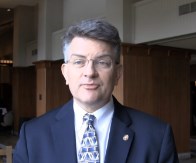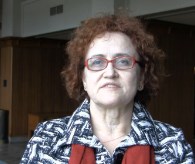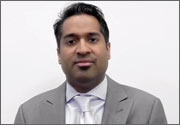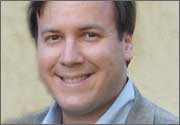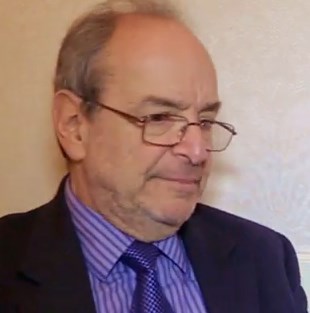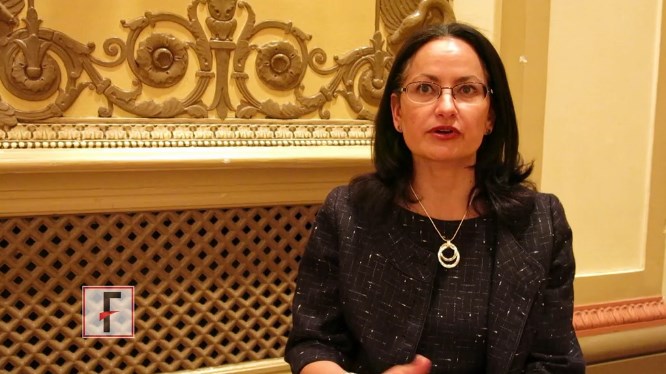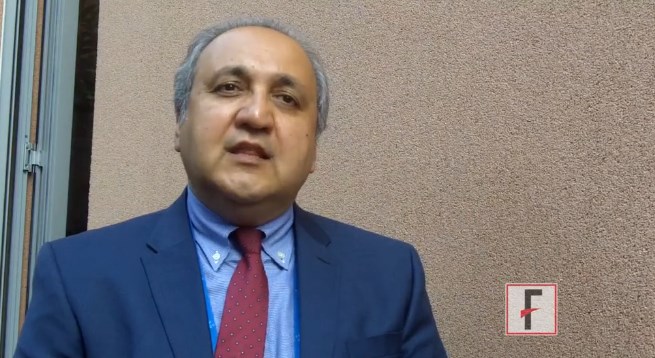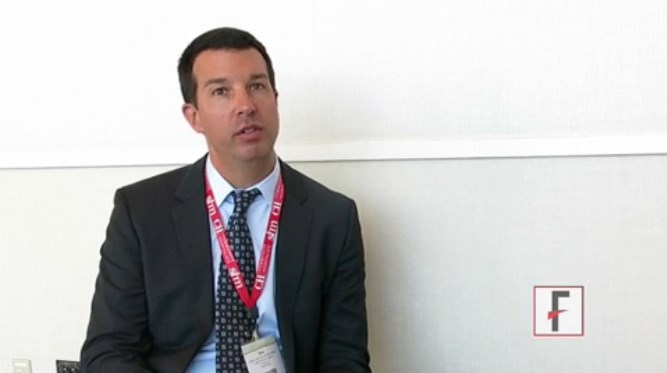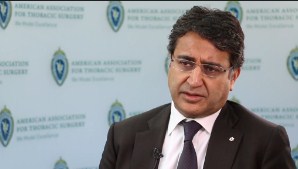User login
VIDEO: Updating the immune response to nonmelanoma skin cancer
ASHEVILLE, N.C. – Recent advances in basic science have shown how the local immune environment in tissue surrounding nonmelanoma skin cancer compares to adjacent normal tissue.
New Mexico Health Sciences Center’s Dr. Andrew Ondo reviewed the latest research in an interview at the annual meeting of the Noah Worcester Dermatological Society. “Each step along the way is a possible target for the treatment of squamous cell carcinoma,” said Dr. Ondo, who indicated that he had no financial conflicts to disclose.
The video associated with this article is no longer available on this site. Please view all of our videos on the MDedge YouTube channel
ASHEVILLE, N.C. – Recent advances in basic science have shown how the local immune environment in tissue surrounding nonmelanoma skin cancer compares to adjacent normal tissue.
New Mexico Health Sciences Center’s Dr. Andrew Ondo reviewed the latest research in an interview at the annual meeting of the Noah Worcester Dermatological Society. “Each step along the way is a possible target for the treatment of squamous cell carcinoma,” said Dr. Ondo, who indicated that he had no financial conflicts to disclose.
The video associated with this article is no longer available on this site. Please view all of our videos on the MDedge YouTube channel
ASHEVILLE, N.C. – Recent advances in basic science have shown how the local immune environment in tissue surrounding nonmelanoma skin cancer compares to adjacent normal tissue.
New Mexico Health Sciences Center’s Dr. Andrew Ondo reviewed the latest research in an interview at the annual meeting of the Noah Worcester Dermatological Society. “Each step along the way is a possible target for the treatment of squamous cell carcinoma,” said Dr. Ondo, who indicated that he had no financial conflicts to disclose.
The video associated with this article is no longer available on this site. Please view all of our videos on the MDedge YouTube channel
EXPERT ANALYSIS FROM NOAH 57
VIDEO: Larger lentigo maligna lesions increase risk
ASHEVILLE, N.C. – What are the risk factors for invasive melanoma in patients with lentigo maligna? Size, for one thing, according to Dr. Suzanne M. Olbricht.
In an interview at the annual meeting of the Noah Worcester Dermatological Society, Dr. Olbricht of the Lahey Hospital and Medical Center in Burlington, Mass., reviewed evidence suggesting that the recurrence rate is highest for large lesions. “This is important information that helps us think about the treatments we can use,” she said.
Dr. Olbricht had no financial conflicts to disclose.
The video associated with this article is no longer available on this site. Please view all of our videos on the MDedge YouTube channel
ASHEVILLE, N.C. – What are the risk factors for invasive melanoma in patients with lentigo maligna? Size, for one thing, according to Dr. Suzanne M. Olbricht.
In an interview at the annual meeting of the Noah Worcester Dermatological Society, Dr. Olbricht of the Lahey Hospital and Medical Center in Burlington, Mass., reviewed evidence suggesting that the recurrence rate is highest for large lesions. “This is important information that helps us think about the treatments we can use,” she said.
Dr. Olbricht had no financial conflicts to disclose.
The video associated with this article is no longer available on this site. Please view all of our videos on the MDedge YouTube channel
ASHEVILLE, N.C. – What are the risk factors for invasive melanoma in patients with lentigo maligna? Size, for one thing, according to Dr. Suzanne M. Olbricht.
In an interview at the annual meeting of the Noah Worcester Dermatological Society, Dr. Olbricht of the Lahey Hospital and Medical Center in Burlington, Mass., reviewed evidence suggesting that the recurrence rate is highest for large lesions. “This is important information that helps us think about the treatments we can use,” she said.
Dr. Olbricht had no financial conflicts to disclose.
The video associated with this article is no longer available on this site. Please view all of our videos on the MDedge YouTube channel
AT NOAH 57
Memory problems: How best to assess and address
Manage Your Dermatology Practice: Media Prep
Developing relationships with the media may help propel your practice forward, but it also creates the opportunity to educate patients about new treatments and dermatology overall. Dr. Gary Goldenberg provides tips for creating clear messages during media interviews.
Developing relationships with the media may help propel your practice forward, but it also creates the opportunity to educate patients about new treatments and dermatology overall. Dr. Gary Goldenberg provides tips for creating clear messages during media interviews.
Developing relationships with the media may help propel your practice forward, but it also creates the opportunity to educate patients about new treatments and dermatology overall. Dr. Gary Goldenberg provides tips for creating clear messages during media interviews.
Novel treatments for depression
The video associated with this article is no longer available on this site. Please view all of our videos on the MDedge YouTube channel
The video associated with this article is no longer available on this site. Please view all of our videos on the MDedge YouTube channel
The video associated with this article is no longer available on this site. Please view all of our videos on the MDedge YouTube channel
VIDEO: Consider adult ADHD in dementia differential diagnosis
CHICAGO – Forgetfulness is one of the most common symptoms of adult attention- deficit/hyperactivity disorder and should “definitely” be considered in the differential diagnosis for dementia in older patients who present with this complaint.
That’s the counsel of Dr. Anthony L. Rostain, professor of psychiatry at the Hospital of the University of Pennsylvania and the Children’s Hospital of Philadelphia, who spoke at Psychiatry Update 2015, sponsored by Current Psychiatry and the American Academy of Clinical Psychiatrists.
“An adult with ADHD may have enough resilience that they’ve been functioning well over the decades, but now it affects their ability to hold a job or maintain a relationship,” Dr. Rostain said. “Primary care doctors are typically the first health professional in a position to help these patients identify and manage their condition.”
Learn more about diagnosing and crafting appropriate treatment regimens for adults with ADHD, including helping them to see it as a chronic disorder, not a stigma or disease.
Current Psychiatry and this news organization are owned by the same parent company.
On Twitter @whitneymcknight
CHICAGO – Forgetfulness is one of the most common symptoms of adult attention- deficit/hyperactivity disorder and should “definitely” be considered in the differential diagnosis for dementia in older patients who present with this complaint.
That’s the counsel of Dr. Anthony L. Rostain, professor of psychiatry at the Hospital of the University of Pennsylvania and the Children’s Hospital of Philadelphia, who spoke at Psychiatry Update 2015, sponsored by Current Psychiatry and the American Academy of Clinical Psychiatrists.
“An adult with ADHD may have enough resilience that they’ve been functioning well over the decades, but now it affects their ability to hold a job or maintain a relationship,” Dr. Rostain said. “Primary care doctors are typically the first health professional in a position to help these patients identify and manage their condition.”
Learn more about diagnosing and crafting appropriate treatment regimens for adults with ADHD, including helping them to see it as a chronic disorder, not a stigma or disease.
Current Psychiatry and this news organization are owned by the same parent company.
On Twitter @whitneymcknight
CHICAGO – Forgetfulness is one of the most common symptoms of adult attention- deficit/hyperactivity disorder and should “definitely” be considered in the differential diagnosis for dementia in older patients who present with this complaint.
That’s the counsel of Dr. Anthony L. Rostain, professor of psychiatry at the Hospital of the University of Pennsylvania and the Children’s Hospital of Philadelphia, who spoke at Psychiatry Update 2015, sponsored by Current Psychiatry and the American Academy of Clinical Psychiatrists.
“An adult with ADHD may have enough resilience that they’ve been functioning well over the decades, but now it affects their ability to hold a job or maintain a relationship,” Dr. Rostain said. “Primary care doctors are typically the first health professional in a position to help these patients identify and manage their condition.”
Learn more about diagnosing and crafting appropriate treatment regimens for adults with ADHD, including helping them to see it as a chronic disorder, not a stigma or disease.
Current Psychiatry and this news organization are owned by the same parent company.
On Twitter @whitneymcknight
EXPERT ANALYSIS FROM PSYCHIATRY UPDATE 2015
VIDEO: Patients with female genital cutting experience inadequate care
CHICAGO– Inappropriate treatment by physicians of women who have undergone female genital cutting (FGC) can block access to further care and harm patients psychologically, according to Dr. Nawal M. Nour, director of the ambulatory obstetrics practice at Brigham and Women’s Hospital and founder of the African Women’s Health Center in Boston.
Doctors who are unfamiliar with patients who have FGC can say or react to patients in ways that harms, rather than helps such women, Dr. Nour said at the annual meeting of the American Medical Women’s Association. Dr. Nour is the lead author of Female Genital Cutting: Clinical Management of Circumcised Women, published by the American Congress of Obstetricians and Gynecologists.
During her presentation, Dr. Nour shared cases in which doctors made teaching examples out of FGC patients, provided inaccurate information about vaginal deliveries, and focused on the FGC procedure, rather the woman’s reason for seeking medical attention.
In this video, Dr. Nour shares some common ways that physicians inappropriately respond to women who have undergone FGC, and how doctors can act more sensitively.
The video associated with this article is no longer available on this site. Please view all of our videos on the MDedge YouTube channel
On Twitter @legal_med
CHICAGO– Inappropriate treatment by physicians of women who have undergone female genital cutting (FGC) can block access to further care and harm patients psychologically, according to Dr. Nawal M. Nour, director of the ambulatory obstetrics practice at Brigham and Women’s Hospital and founder of the African Women’s Health Center in Boston.
Doctors who are unfamiliar with patients who have FGC can say or react to patients in ways that harms, rather than helps such women, Dr. Nour said at the annual meeting of the American Medical Women’s Association. Dr. Nour is the lead author of Female Genital Cutting: Clinical Management of Circumcised Women, published by the American Congress of Obstetricians and Gynecologists.
During her presentation, Dr. Nour shared cases in which doctors made teaching examples out of FGC patients, provided inaccurate information about vaginal deliveries, and focused on the FGC procedure, rather the woman’s reason for seeking medical attention.
In this video, Dr. Nour shares some common ways that physicians inappropriately respond to women who have undergone FGC, and how doctors can act more sensitively.
The video associated with this article is no longer available on this site. Please view all of our videos on the MDedge YouTube channel
On Twitter @legal_med
CHICAGO– Inappropriate treatment by physicians of women who have undergone female genital cutting (FGC) can block access to further care and harm patients psychologically, according to Dr. Nawal M. Nour, director of the ambulatory obstetrics practice at Brigham and Women’s Hospital and founder of the African Women’s Health Center in Boston.
Doctors who are unfamiliar with patients who have FGC can say or react to patients in ways that harms, rather than helps such women, Dr. Nour said at the annual meeting of the American Medical Women’s Association. Dr. Nour is the lead author of Female Genital Cutting: Clinical Management of Circumcised Women, published by the American Congress of Obstetricians and Gynecologists.
During her presentation, Dr. Nour shared cases in which doctors made teaching examples out of FGC patients, provided inaccurate information about vaginal deliveries, and focused on the FGC procedure, rather the woman’s reason for seeking medical attention.
In this video, Dr. Nour shares some common ways that physicians inappropriately respond to women who have undergone FGC, and how doctors can act more sensitively.
The video associated with this article is no longer available on this site. Please view all of our videos on the MDedge YouTube channel
On Twitter @legal_med
AT THE AMWA ANNUAL MEETING
VIDEO: NAFLD increasingly causing U.S. hepatocellular carcinomas
VIENNA – Nonalcoholic fatty liver disease (NAFLD) now stands as the second most common cause of U.S. cases of hepatocellular carcinoma, and with highly effective drug regimens now sharply dropping the prevalence of hepatitis C virus infection, NAFLD – a complication of obesity – is poised to snag the top spot, Dr. Zobair Younossi said in a video interview at the meeting sponsored by the European Association for the Study of the Liver.
In an analysis that combined U.S. national cancer registry data collected by the National Cancer Institute and morbidity diagnostic codes collected by Medicare, Dr. Younossi calculated that, during 2004-2009 among U.S. adults covered by Medicare, 24% of patients newly diagnosed with hepatocellular carcinoma (HCC) had NAFLD as their pre-existing chronic liver disease, compared with 48% who had hepatitis C virus infection as their trigger. The third most common cause of HCC was alcoholic liver disease (14%), followed by hepatitis B virus infection (8%).
Dr. Younossi’s analysis also included survival data for each HCC case in the first year following diagnosis, which showed that NAFLD-associated cases also were deadlier, linking with a statistically significant 20% increase in mortality compared with HCC associated with other causes. Quicker lethality of NAFLD-linked HCC is probably due to the more advanced stage at diagnosis, he said.
The findings highlight the need for improved surveillance in these patients, a process complicated by the challenge of imaging the liver in obese patients, said Dr. Younossi, chairman of medicine and head of the Center for Liver Diseases at Inova Fairfax Hospital in Falls Church, Va.
Dr. Younossi has been a consultant to Gilead, Abbvie, Bristol-Myers Squibb, GlaxoSmithKline, Intercept, and Salix.
The video associated with this article is no longer available on this site. Please view all of our videos on the MDedge YouTube channel
VIENNA – Nonalcoholic fatty liver disease (NAFLD) now stands as the second most common cause of U.S. cases of hepatocellular carcinoma, and with highly effective drug regimens now sharply dropping the prevalence of hepatitis C virus infection, NAFLD – a complication of obesity – is poised to snag the top spot, Dr. Zobair Younossi said in a video interview at the meeting sponsored by the European Association for the Study of the Liver.
In an analysis that combined U.S. national cancer registry data collected by the National Cancer Institute and morbidity diagnostic codes collected by Medicare, Dr. Younossi calculated that, during 2004-2009 among U.S. adults covered by Medicare, 24% of patients newly diagnosed with hepatocellular carcinoma (HCC) had NAFLD as their pre-existing chronic liver disease, compared with 48% who had hepatitis C virus infection as their trigger. The third most common cause of HCC was alcoholic liver disease (14%), followed by hepatitis B virus infection (8%).
Dr. Younossi’s analysis also included survival data for each HCC case in the first year following diagnosis, which showed that NAFLD-associated cases also were deadlier, linking with a statistically significant 20% increase in mortality compared with HCC associated with other causes. Quicker lethality of NAFLD-linked HCC is probably due to the more advanced stage at diagnosis, he said.
The findings highlight the need for improved surveillance in these patients, a process complicated by the challenge of imaging the liver in obese patients, said Dr. Younossi, chairman of medicine and head of the Center for Liver Diseases at Inova Fairfax Hospital in Falls Church, Va.
Dr. Younossi has been a consultant to Gilead, Abbvie, Bristol-Myers Squibb, GlaxoSmithKline, Intercept, and Salix.
The video associated with this article is no longer available on this site. Please view all of our videos on the MDedge YouTube channel
VIENNA – Nonalcoholic fatty liver disease (NAFLD) now stands as the second most common cause of U.S. cases of hepatocellular carcinoma, and with highly effective drug regimens now sharply dropping the prevalence of hepatitis C virus infection, NAFLD – a complication of obesity – is poised to snag the top spot, Dr. Zobair Younossi said in a video interview at the meeting sponsored by the European Association for the Study of the Liver.
In an analysis that combined U.S. national cancer registry data collected by the National Cancer Institute and morbidity diagnostic codes collected by Medicare, Dr. Younossi calculated that, during 2004-2009 among U.S. adults covered by Medicare, 24% of patients newly diagnosed with hepatocellular carcinoma (HCC) had NAFLD as their pre-existing chronic liver disease, compared with 48% who had hepatitis C virus infection as their trigger. The third most common cause of HCC was alcoholic liver disease (14%), followed by hepatitis B virus infection (8%).
Dr. Younossi’s analysis also included survival data for each HCC case in the first year following diagnosis, which showed that NAFLD-associated cases also were deadlier, linking with a statistically significant 20% increase in mortality compared with HCC associated with other causes. Quicker lethality of NAFLD-linked HCC is probably due to the more advanced stage at diagnosis, he said.
The findings highlight the need for improved surveillance in these patients, a process complicated by the challenge of imaging the liver in obese patients, said Dr. Younossi, chairman of medicine and head of the Center for Liver Diseases at Inova Fairfax Hospital in Falls Church, Va.
Dr. Younossi has been a consultant to Gilead, Abbvie, Bristol-Myers Squibb, GlaxoSmithKline, Intercept, and Salix.
The video associated with this article is no longer available on this site. Please view all of our videos on the MDedge YouTube channel
AT THE INTERNATIONAL LIVER CONGRESS 2015
SHM VIDEO: Provider continuity, workload reduction improves patient throughput
NATIONAL HARBOR, MD.– Clogs in patient throughput often are caused by top-heavy workloads, poor staffing models, and unbalanced patient to provider ratios, said Dr. Dean Dalili, vice president for medical affairs at Hospital Physician Partners, a practice management company based in Hollywood, Fla.
Hospitalists can manage such patient flow challenges by analyzing staff capacity and developing creative approaches to patient demand, Dr. Dalili said at the annual meeting of the Society of Hospital Medicine.
In this video, Dr. Dalili shares common reasons for patient throughput holdups and strategies that hospitalists and other doctors can employ to alleviate the problems. He also discusses how physician documentation can affect payment, performance and length of stay.
The video associated with this article is no longer available on this site. Please view all of our videos on the MDedge YouTube channel
On Twitter @legal_med
NATIONAL HARBOR, MD.– Clogs in patient throughput often are caused by top-heavy workloads, poor staffing models, and unbalanced patient to provider ratios, said Dr. Dean Dalili, vice president for medical affairs at Hospital Physician Partners, a practice management company based in Hollywood, Fla.
Hospitalists can manage such patient flow challenges by analyzing staff capacity and developing creative approaches to patient demand, Dr. Dalili said at the annual meeting of the Society of Hospital Medicine.
In this video, Dr. Dalili shares common reasons for patient throughput holdups and strategies that hospitalists and other doctors can employ to alleviate the problems. He also discusses how physician documentation can affect payment, performance and length of stay.
The video associated with this article is no longer available on this site. Please view all of our videos on the MDedge YouTube channel
On Twitter @legal_med
NATIONAL HARBOR, MD.– Clogs in patient throughput often are caused by top-heavy workloads, poor staffing models, and unbalanced patient to provider ratios, said Dr. Dean Dalili, vice president for medical affairs at Hospital Physician Partners, a practice management company based in Hollywood, Fla.
Hospitalists can manage such patient flow challenges by analyzing staff capacity and developing creative approaches to patient demand, Dr. Dalili said at the annual meeting of the Society of Hospital Medicine.
In this video, Dr. Dalili shares common reasons for patient throughput holdups and strategies that hospitalists and other doctors can employ to alleviate the problems. He also discusses how physician documentation can affect payment, performance and length of stay.
The video associated with this article is no longer available on this site. Please view all of our videos on the MDedge YouTube channel
On Twitter @legal_med
AT HOSPITAL MEDICINE 15
VIDEO: Eventually, patients may be on ECLS for years, not months
SEATTLE – Extracorporeal lung support (ECLS) has evolved to the point where it can keep people alive for months as they await lung transplants. There’s also an emerging role for ELS after transplant.
The technology, however, is not for everyone, according to draft guidelines from the American Association for Thoracic Surgery. They cover dozens of ins and outs about ECLS, including how to pick the right patients and how to best perform the procedure.
The technology is ever improving, so it’s possible to imagine ECLS being used for years at some point, instead of months, guideline coauthor Dr. Shaf Keshavjee, a thoracic surgeon at the University of Toronto, explained in a video interview at the annual meeting of the American Association for Thoracic Surgery.
The video associated with this article is no longer available on this site. Please view all of our videos on the MDedge YouTube channel
SEATTLE – Extracorporeal lung support (ECLS) has evolved to the point where it can keep people alive for months as they await lung transplants. There’s also an emerging role for ELS after transplant.
The technology, however, is not for everyone, according to draft guidelines from the American Association for Thoracic Surgery. They cover dozens of ins and outs about ECLS, including how to pick the right patients and how to best perform the procedure.
The technology is ever improving, so it’s possible to imagine ECLS being used for years at some point, instead of months, guideline coauthor Dr. Shaf Keshavjee, a thoracic surgeon at the University of Toronto, explained in a video interview at the annual meeting of the American Association for Thoracic Surgery.
The video associated with this article is no longer available on this site. Please view all of our videos on the MDedge YouTube channel
SEATTLE – Extracorporeal lung support (ECLS) has evolved to the point where it can keep people alive for months as they await lung transplants. There’s also an emerging role for ELS after transplant.
The technology, however, is not for everyone, according to draft guidelines from the American Association for Thoracic Surgery. They cover dozens of ins and outs about ECLS, including how to pick the right patients and how to best perform the procedure.
The technology is ever improving, so it’s possible to imagine ECLS being used for years at some point, instead of months, guideline coauthor Dr. Shaf Keshavjee, a thoracic surgeon at the University of Toronto, explained in a video interview at the annual meeting of the American Association for Thoracic Surgery.
The video associated with this article is no longer available on this site. Please view all of our videos on the MDedge YouTube channel
AT THE AATS ANNUAL MEETING
